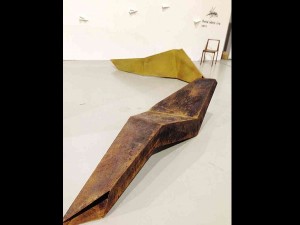Furnishings for the global market

DANIEL Latorre Cruz’s functional metalwork: several twisted geometric metal sculptures and their experimental, reinforced concrete counterparts. Their hollowed sections can accommodate accent lighting.
Some 15 years ago, a European furniture distributor told me that the Philippines was known as the “prototype capital” of the world, where furniture samples were done so well for exhibition but could rarely be mass-produced with the same quality level. But 15 years later, we have gone beyond the prototype, and the local furniture industry continues to flourish and penetrate markets at every corner of the world with its beautiful and well-crafted pieces.
Last week, the Center for International Trade Expositions and Missions (Citem) hosted its biannual “Next One Now,” a trade fair showcasing our locally designed and manufactured furniture and accessories. It is one of the most successful international fairs and also one of the longest-running trade shows in Asia-Pacific. So, off I went on a sunny Sunday to see what the industry had in store for the year.
One of my first stops was Vincent Padua’s display of modern furniture. His brand is probably one of the more consistent in terms of its high level of aesthetic quality and workmanship for all of upholstery, woodwork and metalwork. The newer pieces seen in his collection are faceted and triangulated furniture pieces crafted from wood veneer, woodwork on stainless steel frames, glass and stainless steel combos, and furniture made from laminated marine plywood shards, excess material from the fabrication of many other pieces.
Reclaimed wood collection
A few months ago, De La Salle University ordered furniture pieces for its new Administration Building and library, of which we designed. The pieces turned up with excellent workmanship, especially in the upholstery department where many other furniture manufacturers usually fail.
Philippine-born, UK-educated, and recently “reimported” back into his homeland, Daniel Latorre Cruz showed us his functional metalwork: several twisted geometric metal sculptures and their experimental, reinforced concrete counterparts.
One of the pieces on display was left outdoors to weather many months prior to the exhibit, and thus developed an oxidized coat that was part rust, part blotch and very organic. It is something “from the soil, that will one day return to the soil,” as he’s said. Its concrete counterpart, on the other hand, may be more palatable to the less adventurous, and can be utilized for more commercial purposes.
Far East Furniture had a collection of reclaimed wood: tabletops from chunks of excess hardwood, mounted on stainless steel legs and topped with clear glass, and a version using “traviesas” or old railroad tracks, which surprisingly, are not from our local railroad! According to Far East Furniture’s Jan Krenn, the old tracks are imported from places like Russia and China, and the tables are fabricated in their Pampanga factory to be eventually re-exported to Europe.
In another vignette display, metal pieces in fractal shapes came together to form console tables, armchairs and a variety of pendant lamps. They were different, with rough, organic and gothic textures fusing into some very unique and avant-garde items. These forward-looking furnishing by Industria Vico’s Eric Parac and Jude Tiotuico were made largely with black iron and finished in either gunmetal, copper, or other bronze coats.
Pendant lamps
Notable too were Triboa Bay’s large pendant lamps using the lightweight and fast-growing gmelina timber, cut to appear like bentwood, expressing a character that’s so 1950s. These pieces could sell very well in the local market considering the scale of which they can be fabricated and the price points they had.
Over at Kenneth Cobonpue’s Hive Studio, what caught my eye were the various colored pendant lamps that hung above their display space. Reminding me of a more streamlined and robust version of “macramé” lamps, these jewel-toned fixtures made from hoops and thick cotton rope hung from stainless steel cables, a small detail that undoubtedly—and despite the seemingly traditional method of handling rope—contributed to the lamps’ contemporary flavor. On the floor too were furniture pieces that exhibited unique weaving and construction methods using traditional materials. Here, Cobonpue plays with texture and scale in many unusual ways, so much so that one will understand clearly why his pieces can very well compete in the international market.
Which brings me to the big mission of our furniture and accessory industry: to create innovative and inherently Filipino products utilizing local materials that are infused with a strong international favor. With these, we’re in the game.
We also need to instill in our craftsmen the discipline and love for perfection, and develop manufacturing processes that will guarantee faithfulness to design and quality on a large scale. We’ve already gone way beyond the one-shot-deal prototyping, and we will continue to go places with our design ingenuity. The trade show title of Next One Now is just so appropriate.
Contact the author through [email protected] or through our Asuncion Berenguer Facebook account.














